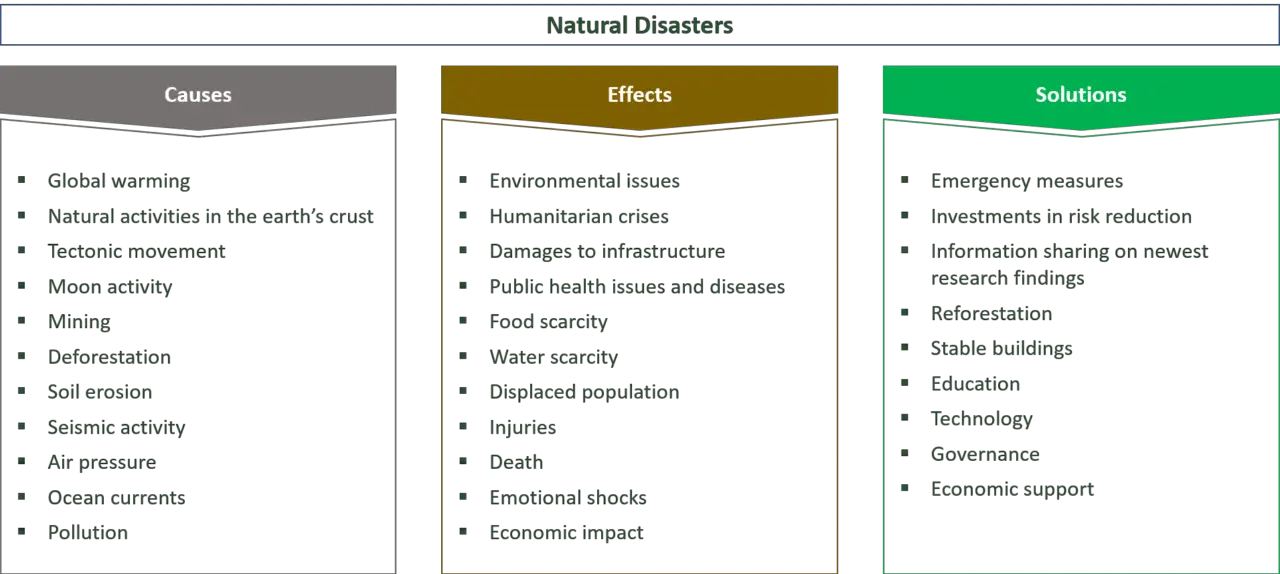Analyses & Forecasts
▾
Data & Tools
▾
Educational Resources
▾
Archives
▾
About
▾
Search
Search ForNWS All NOAA
▾
Climatology | Names | Wind Scale | Extremes | Models | Breakpoints
Experience shows that the use of short, distinctive names in written as well as spoken communications is quicker and less subject to error than the older, more cumbersome latitude-longitude identification methods.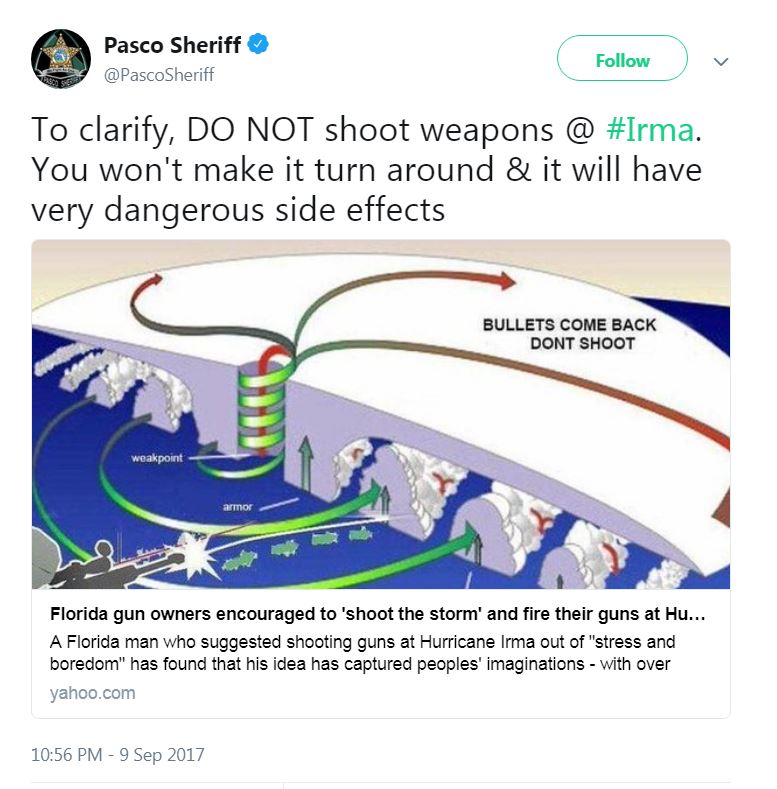 These advantages are especially important in exchanging detailed storm information between hundreds of widely scattered stations, coastal bases, and ships at sea.
These advantages are especially important in exchanging detailed storm information between hundreds of widely scattered stations, coastal bases, and ships at sea.
The use of easily remembered names greatly reduces confusion when two or more tropical storms occur at the same time. For example, one hurricane can be moving slowly westward in the Gulf of Mexico, while at exactly the same time another hurricane can be moving rapidly northward along the Atlantic coast. In the past, confusion and false rumors have arisen when storm advisories broadcast from radio stations were mistaken for warnings concerning an entirely different storm located hundreds of miles away.
Can I have a tropical cyclone named for me?
For several hundred years many hurricanes in the West Indies were named after the particular saint's day on which the hurricane occurred. Ivan R. Tannehill describes in his book "Hurricanes" the major tropical storms of recorded history and mentions many hurricanes named after saints. For example, there was "Hurricane Santa Ana" which struck Puerto Rico with exceptional violence on July 26, 1825, and "San Felipe" (the first) and "San Felipe" (the second) which hit Puerto Rico on September 13 in both 1876 and 1928.
For example, there was "Hurricane Santa Ana" which struck Puerto Rico with exceptional violence on July 26, 1825, and "San Felipe" (the first) and "San Felipe" (the second) which hit Puerto Rico on September 13 in both 1876 and 1928.
Tannehill also tells of Clement Wragge, an Australian meteorologist who began giving women's names to tropical storms before the end of the 19th century.
An early example of the use of a woman's name for a storm was in the novel "Storm" by George R. Stewart, published by Random House in 1941, and since filmed by Walt Disney. During World War II this practice became widespread in weather map discussions among forecasters, especially Army and Navy meteorologists who plotted the movements of storms over the wide expanses of the Pacific Ocean.
In 1953, the United States abandoned a confusing two-year old plan to name storms by a phonetic alphabet (Able, Baker, Charlie) when a new, international phonetic alphabet was introduced. That year, the United States began using female names for storms.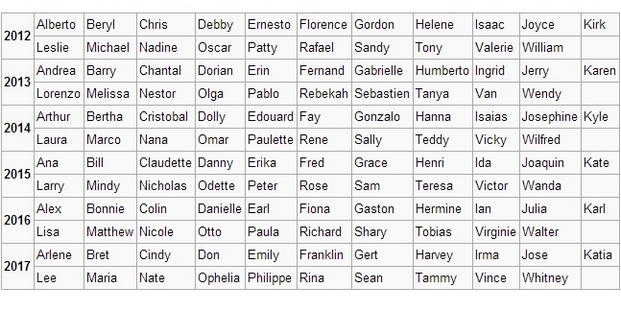
The practice of naming hurricanes solely after women came to an end in 1978 when men's and women's names were included in the Eastern North Pacific storm lists. In 1979, male and female names were included in lists for the Atlantic and Gulf of Mexico.
The NHC does not control the naming of tropical storms. Instead a strict procedure has been established by an international committee of the World Meteorological Organization.
For Atlantic hurricanes, there is a list of names for each of six years. In other words, one list is repeated every sixth year. The only time that there is a change is if a storm is so deadly or costly that the future use of its name on a different storm would be inappropriate for obvious reasons of sensitivity. If that occurs, then at an annual meeting by the committee (called primarily to discuss many other issues) the offending name is stricken from the list and another name is selected to replace it.
There is an exception to the retirement rule, however. Before 1979, when the first permanent six-year storm name list began, some storm names were simply not used anymore. For example, in 1966, "Fern" was substituted for "Frieda," and no reason was cited.
Below is a list of retired names for the Atlantic Ocean, Caribbean Sea, and the Gulf of Mexico. There are, however, a great number of destructive storms not included on this list because they occurred before the hurricane naming convention was established in 1950.
Can I have a tropical cyclone named for me?
| 1954 Carol Hazel Edna | 1955 Connie Diane Ione Janet | 1956 | 1957 Audrey | 1958 | 1959 | 1960 Donna | 1961 Carla Hattie | ||
| 1962 | 1963 Flora | 1964 Cleo Dora Hilda | 1965 Betsy | 1966 Inez | 1967 Beulah | 1968 | 1969 Camille | 1970 Celia | 1971 |
| 1972 Agnes | 1973 | 1974 Carmen Fifi | 1975 Eloise | 1976 | 1977 Anita | 1978 Greta | 1979 David Frederic | 1980 Allen | 1981 |
| 1982 | 1983 Alicia | 1984 | 1985 Elena Gloria | 1986 | 1987 | 1988 Gilbert Joan | 1989 Hugo | 1990 Diana Klaus | 1991 Bob |
| 1992 Andrew | 1993 | 1994 | 1995 Luis Marilyn Opal Roxanne | 1996 Cesar Fran Hortense | 1997 | 1998 Georges Mitch | 1999 Floyd Lenny | 2000 Keith | 2001 Allison Iris Michelle |
| 2002 Isidore Lili | 2003 Fabian Isabel Juan | 2004 Charley Frances Ivan Jeanne | 2005 Dennis Katrina Rita Stan Wilma | 2006 | 2007 Dean Felix Noel | 2008 Gustav Ike Paloma | 2009 | 2010 Igor Tomas | 2011 Irene |
| 2012 Sandy | 2013 Ingrid | 2014 | 2015 Erika Joaquin | 2016 Matthew Otto | 2017 Harvey Irma Maria Nate | 2018 Florence Michael | 2019 Dorian | 2020 Laura Eta Iota | 2021 Ida |
| 2022 Fiona Ian | |||||||||
| Agnes | 1972 | |
| Alicia | 1983 | |
| Allen | 1980 | |
| Allison | 2001 | |
| Andrew | 1992 | |
| Anita | 1977 | |
| Audrey | 1957 | |
| Betsy | 1965 | |
| Beulah | 1967 | |
| Bob | 1991 | |
| Camille | 1969 | |
| Carla | 1961 | |
| Carmen | 1974 | |
| Carol | 1954 | |
| Celia | 1970 | |
| Cesar | 1996 | |
| Charley | 2004 | |
| Cleo | 1964 | |
| Connie | 1955 | |
| David | 1979 | |
| Dean | 2007 | |
| Dennis | 2005 | |
| Diana | 1990 | |
| Diane | 1955 | |
| Donna | 1960 | |
| Dora | 1964 | |
| Dorian | 2019 | |
| Edna | 1954 | |
| Elena | 1985 | |
| Eloise | 1975 | |
| Erika | 2015 | |
| Eta | 2020 | |
| Fabian | 2003 | |
| Felix | 2007 | |
| Fifi | 1974 | |
| Fiona | 2022 | |
| Flora | 1963 | |
| Florence | 2018 | |
| Floyd | 1999 | |
| Fran | 1996 | |
| Frances | 2004 | |
| Frederic | 1979 | |
| Georges | 1998 | |
| Gilbert | 1988 | |
| Gloria | 1985 | |
| Greta | 1978 | |
| Gustav | 2008 | |
| Harvey | 2017 | |
| Hattie | 1961 | |
| Hazel | 1954 | |
| Hilda | 1964 | |
| Hortense | 1996 | |
| Hugo | 1989 | |
| Ian | 2022 | |
| Ida | 2021 | |
| Igor | 2010 | |
| Ike | 2008 | |
| Inez | 1966 | |
| Ingrid | 2013 | |
| Ione | 1955 | |
| Iota | 2020 | |
| Irene | 2011 | |
| Iris | 2001 | |
| Irma | 2017 | |
| Isabel | 2003 | |
| Isidore | 2002 | |
| Ivan | 2004 | |
| Janet | 1955 | |
| Jeanne | 2004 | |
| Joan | 1988 | |
| Joaquin | 2015 | |
| Juan | 2003 | |
| Katrina | 2005 | |
| Keith | 2000 | |
| Klaus | 1990 | |
| Laura | 2020 | |
| Lenny | 1999 | |
| Lili | 2002 | |
| Luis | 1995 | |
| Maria | 2017 | |
| Marilyn | 1995 | |
| Matthew | 2016 | |
| Michael | 2018 | |
| Michelle | 2001 | |
| Mitch | 1998 | |
| Nate | 2017 | |
| Noel | 2007 | |
| Opal | 1995 | |
| Otto | 2016 | |
| Paloma | 2008 | |
| Rita | 2005 | |
| Roxanne | 1995 | |
| Sandy | 2012 | |
| Stan | 2005 | |
| Tomas | 2010 | |
| Wilma | 2005 |
| 1965 Hazel | 1966 | 1967 | 1968 | 1969 | 1970 Adele | 1971 | |||
| 1972 | 1973 | 1974 | 1975 | 1976 | 1977 | 1978 Fico | 1979 | 1980 | 1981 |
| 1982 Iwa | 1983 | 1984 | 1985 | 1986 | 1987 Knut | 1988 Iva | 1989 | 1990 | 1991 Fefa |
| 1992 Iniki | 1993 | 1994 | 1995 Ismael | 1996 | 1997 Pauline Paka | 1998 | 1999 | 2000 | 2001 Adolph |
| 2002 Kenna | 2003 | 2004 Isis | 2005 | 2006 Ioke | 2007 | 2008 Alma | 2009 | 2010 | 2011 |
| 2012 | 2013 Manuel | 2014 Odile | 2015 Patricia | 2016 | 2017 | 2018 | 2019 | 2020 | 2021 |
| 2022 | |||||||||
| Adele | 1970 | |
| Adolph | 2001 | |
| Alma | 2008 | |
| Fefa | 1991 | |
| Fico | 1978 | |
| Hazel | 1965 | |
| Ioke | 2006 | |
| Isis | 2004 | |
| Ismael | 1995 | |
| Iniki | 1992 | |
| Iva | 1988 | |
| Iwa | 1982 | |
| Kenna | 2002 | |
| Knut | 1987 | |
| Manuel | 2013 | |
| Odile | 2014 | |
| Paka | 1997 | |
| Patricia | 2015 | |
| Pauline | 1997 |
In the event that more than twenty-one named tropical cyclones occur in the Atlantic basin in a season, or more than twenty-four named tropical cyclones in the eastern North Pacific basin, any additional storms will take names from an alternate list of names approved by the WMO for each basin.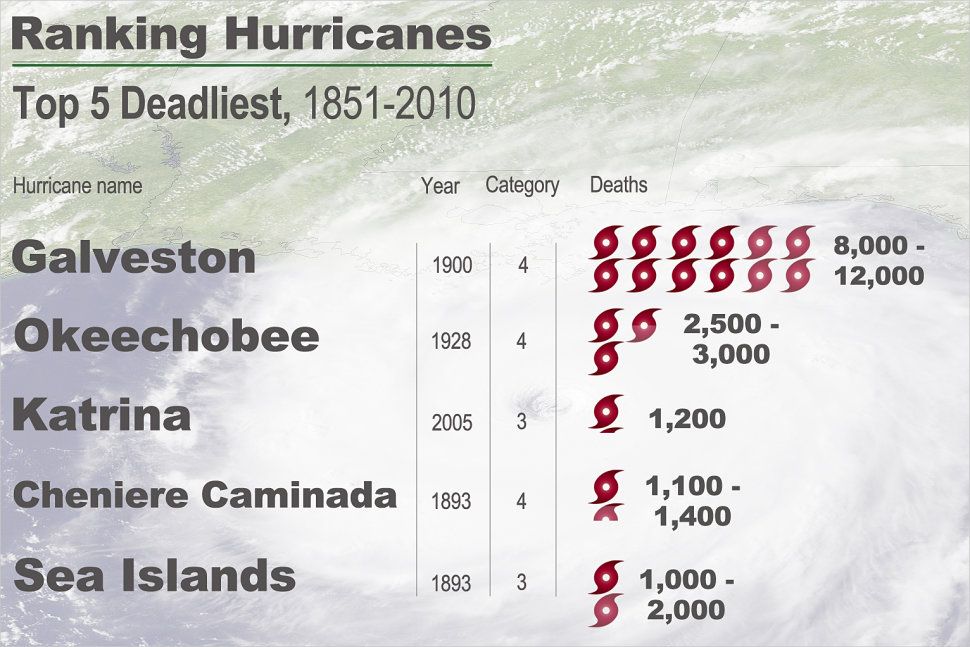 This naming convention has been established by the World Meteorological Organization Tropical Cyclone Programme.
This naming convention has been established by the World Meteorological Organization Tropical Cyclone Programme.
| Atlantic Basin | Eastern North Pacific Basin |
|---|---|
| Adria Braylen Caridad Deshawn Emery Foster Gemma Heath Isla Jacobus Kenzie Lucio Makayla Nolan Orlanda Pax Ronin Sophie Tayshaun Viviana Will | Aidan Bruna Carmelo Daniella Esteban Flor Gerardo Hedda Izzy Jacinta Kenito Luna Marina Nancy Ovidio Pia Rey Skylar Teo Violeta Wilfredo Xinia Yariel Zoe |
Hurricanes began getting names in 1950, when the U. S. Weather Bureau began using the phonetic alphabet (Able-Baker-Charlie).
S. Weather Bureau began using the phonetic alphabet (Able-Baker-Charlie).
In 1953, womens names were substituted, and in 1979, the World Meteorological Organization (WMO) and the U.S. National Weather Service switched to a list of names that also included men's names. The current list of names recycles every six years, unless a hurricane gets its name retired. Any nation impacted by a severe hurricane can lobby the WMO to have the hurricane's name retired. From 1950 - 2011, 76 hurricanes had their names retired. The list includes one tropical storm, Allison of 2001, that caused billions in damage from its heavy rains. Only three Eastern Pacific hurricanes have had their names retired; Hurricane Ismael of 1995, Hurricane Pauline of 1997, and Hurricane Kenna of 2002.
The storm with the most appearances so far is Arlene, which has appeared ten times: 1959, 1963, 1967, 1971, 1981, 1987, 1993, 1999, 2005, 2011, and will come again in 2017. One exception to the retirement rule: before 1979, some storm names were simply dropped.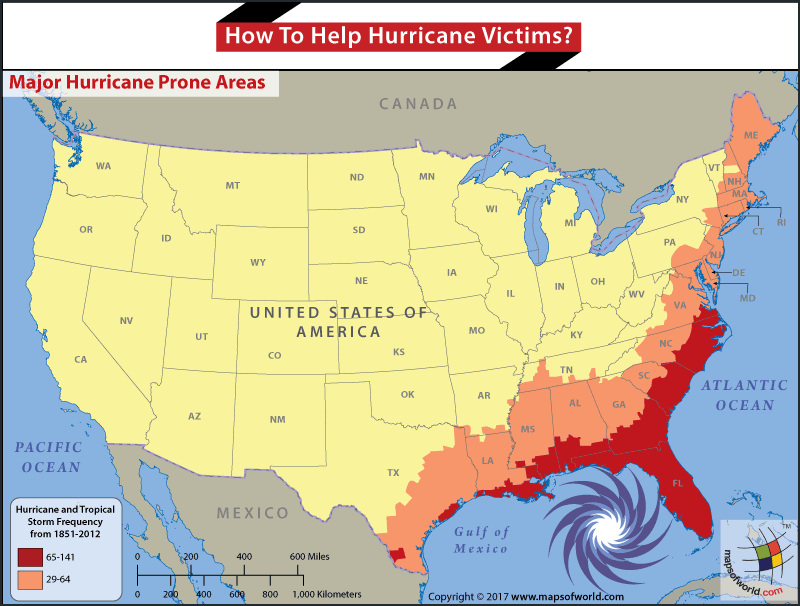 For example, in 1966, Fern was substituted for Frieda, and no reason was given.
For example, in 1966, Fern was substituted for Frieda, and no reason was given.
Below is a list of Atlantic Ocean retired names, the years the hurricanes occurred, and the areas they affected. Keep in mind that a large number of destructive storms occurred before naming began in 1950, and are not included on this list.
| Year | Name | Areas Affected |
|---|---|---|
| 2012 | Sandy | Jamaica, Cuba, Bahamas, Mid-Atlantic, Northeast U.S. |
| 2011 | Irene | Bahamas, Mid-Atlantic, Northeast U.S. |
| 2010 | Tomas | Barbados, St. Vincent, St. Lucia, Haiti, Turks and Caicos |
| 2010 | Igor | Newfoundland, Bermuda |
| 2008 | Paloma | Cayman Islands, Cuba |
| 2008 | Ike | Turks and Caicos, Cuba, Texas |
| 2008 | Gustav | Haiti, Jamaica, Cayman Islands, Cuba, Louisiana |
| 2007 | Noel | Hispaniola, Puerto Rico, Cuba, Bahamas |
| 2007 | Felix | Nicaragua, Honduras |
| 2007 | Dean | Mexico, Jamaica |
| 2005 | Wilma | Cuba, Florida |
| 2005 | Stan | Mexico, Guatemala, El Salvador |
| 2005 | Rita | Louisiana, Texas, Florida |
| 2005 | Katrina | Louisiana, Mississippi, Alabama, Florida |
| 2005 | Dennis | Cuba, Florida |
| 2004 | Jeanne | Florida, Haiti |
| 2004 | Ivan | Grenada, Cayman Islands, Cuba, Alabama, Florida |
| 2004 | Frances | Florida |
| 2004 | Charley | Cuba, Florida |
| 2003 | Juan | Nova Scotia |
| 2003 | Isabel | North Carolina, Virginia, Maryland |
| 2003 | Fabian | Bermuda |
| 2002 | Lili | Cuba, Louisiana |
| 2002 | Isidore | Cuba, Mexico, Louisiana |
| 2001 | Michelle | Cuba, Bahamas |
| 2001 | Iris | Belize |
| 2001 | Allison | Texas |
| 2000 | Keith | Belize, Mexico |
| 1999 | Lenny | Virgin Islands, St.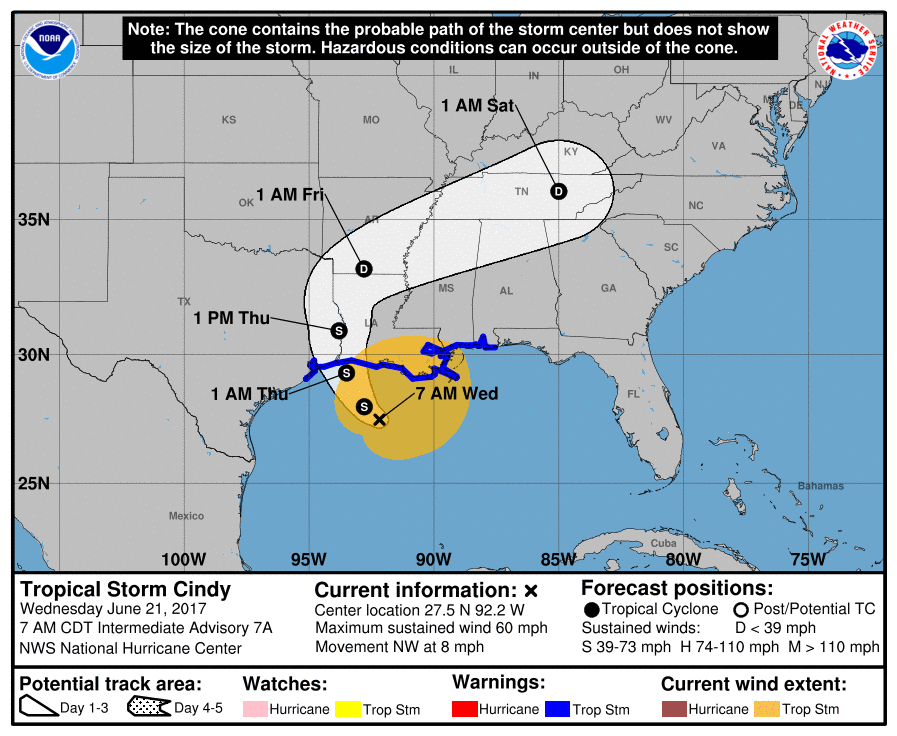 Maartin/St. Martin, Anguilla Maartin/St. Martin, Anguilla |
| 1999 | Floyd | North Carolina |
| 1998 | Mitch | Central America, Nicaragua, Honduras |
| 1998 | Georges | Lesser Antilles, Puerto Rico, Hispaniola, Cuba, Mississippi |
| 1996 | Hortense | Puerto Rico, Dominican Republic |
| 1996 | Fran | North Carolina |
| 1996 | Cesar | Nicaragua |
| 1995 | Roxanne | Mexico |
| 1995 | Opal | Florida |
| 1995 | Marilyn | Virgin Islands, Leeward Islands |
| 1995 | Luis | Leeward Islands |
| 1992 | Andrew | Bahamas, South Florida, Northeast U.S. |
| 1991 | Bob | North Carolina, Northeast U.S. |
| 1990 | Klaus | Martinique |
| 1990 | Diana | Mexico |
| 1989 | Hugo | Antilles, South Carolina |
| 1988 | Joan | Curacao, Venezuela, Colombia, Nicaragua (Crossed into the Pacific) |
| 1988 | Gilbert | Lesser Antilles, Jamaica, Yucatan Peninsula, Mexico |
| 1985 | Gloria | North Carolina, Northeast U. S. S. |
| 1985 | Elena | Mississippi, Alabama, Western Florida |
| 1983 | Alicia | Texas |
| 1980 | Allen | Antilles, Mexico, South Texas |
| 1979 | Frederic | Alabama, Mississippi |
| 1979 | David | Lesser Antilles, Hispaniola, Florida, Eastern U.S. |
| 1977 | Anita | Mexico |
| 1975 | Eloise | Antilles, Northwest Florida, Alabama |
| 1974 | Fifi | Honduras, Guatemala |
| 1974 | Carmen | Mexico, Louisiana |
| 1972 | Agnes | Florida, Northeast U.S. |
| 1970 | Celia | South Texas |
| 1969 | Camille | Mississippi |
| 1967 | Beulah | Antilles, Mexico, South Texas |
| 1966 | Inez | Lesser Antilles, Hispaniola, Cuba, Florida Keys, Mexico |
| 1965 | Betsy | Bahamas, Southeast Florida, Southeast Louisiana |
| 1964 | Dora | Northeast Florida |
| 1964 | Cleo | Lesser Antilles, Haiti, Cuba, Southeast Florida |
| 1964 | Hilda | Louisiana |
| 1963 | Flora | Haiti, Cuba |
| 1961 | Hattie | Belize, Guatemala |
| 1961 | Carla | Texas |
| 1960 | Donna | Bahamas, Florida, Eastern U.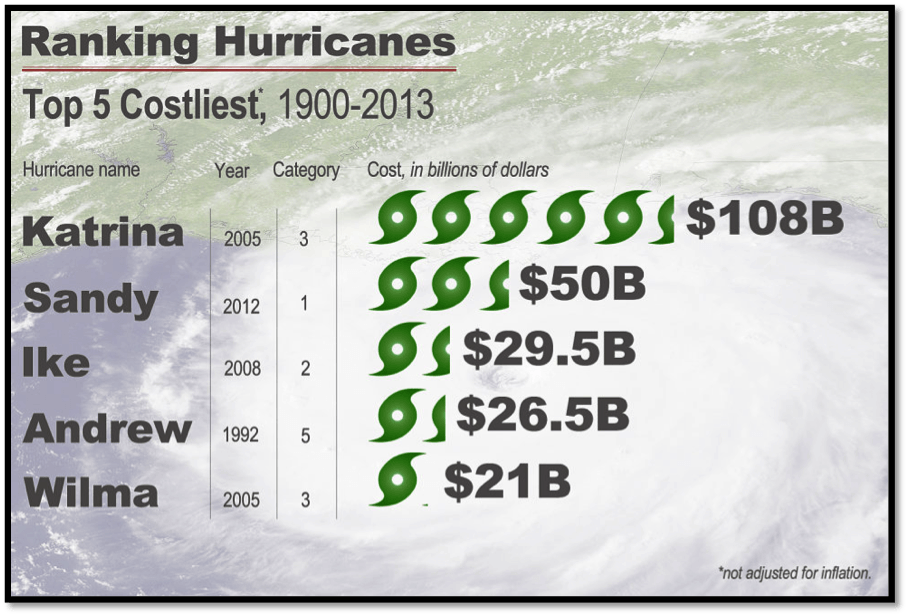 S. S. |
| 1957 | Audrey | Louisiana, Northeast Texas |
| 1955 | Janet | Lesser Antilles, Belize, Mexico |
| 1955 | Ione | North Carolina |
| 1955 | Diane | Mid-Atlantic U.S., Northeast U.S. |
| 1955 | Connie | North Carolina |
| 1954 | Hazel | Antilles, North Carolina, South Carolina |
| 1954 | Edna | Massachusetts |
| 1954 | Carol | Northeast U.S. |
Select basin
Select a year
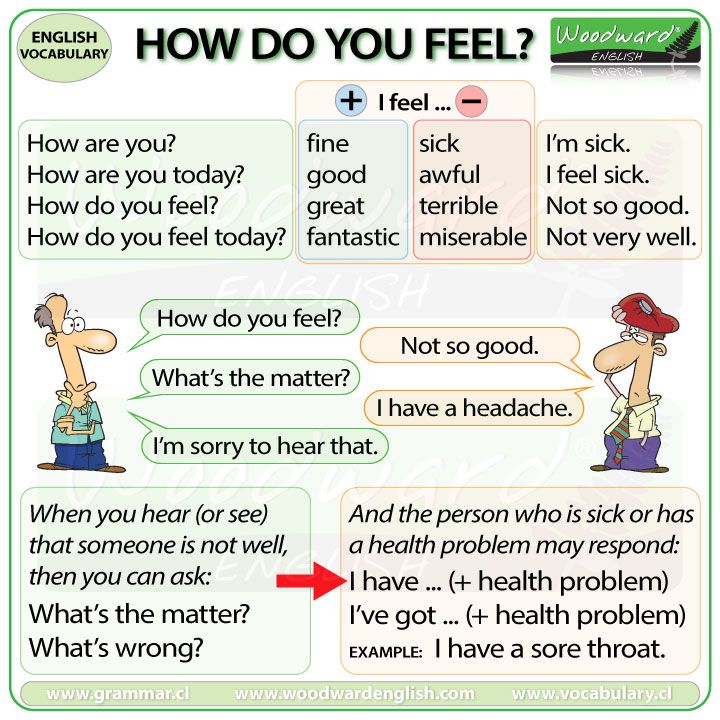 S. Weather Disasters Since 1980
S. Weather Disasters Since 1980Visit the Complete Hurricane Archive
September 19, 2017, 16:26
Society
It is customary to give names to hurricanes to avoid misunderstandings in weather forecasting.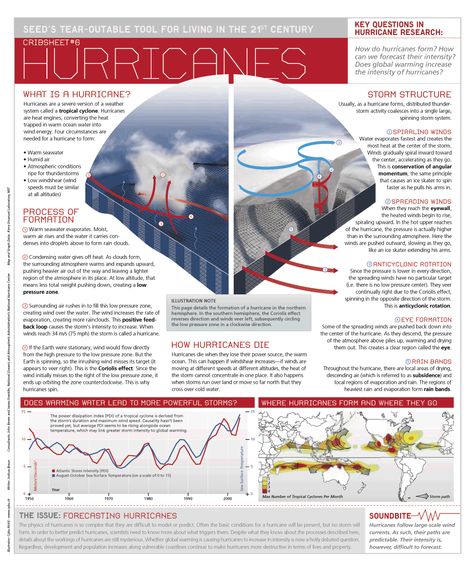 Read about how the names for the elements are chosen in the material of the Moscow 24 portal. weather forecasting, because during the hurricane season, the paths of some of them intersected. Then meteorologists for the names of hurricanes began to use geographical coordinates or the name of the saint on whose day the disaster occurred.
Read about how the names for the elements are chosen in the material of the Moscow 24 portal. weather forecasting, because during the hurricane season, the paths of some of them intersected. Then meteorologists for the names of hurricanes began to use geographical coordinates or the name of the saint on whose day the disaster occurred.
In addition, until 1950, hurricanes were assigned four-digit numbers, the first two digits of which denoted the year, the second two - the serial number of the hurricane in the current year.
Giving names to hurricanes began during World War II. Members of the United States Air Force and Navy, tracking typhoons in the Pacific, gave the anomalies the names of their wives and lovers. But already in 1953 this method was officially approved. And since 1978, hurricanes have been given male names too.
Japan uses its own naming system for natural disasters; hurricanes are named after animals, flowers, trees, and foods: Nakri, Yufung, Kanmuri, Kopu.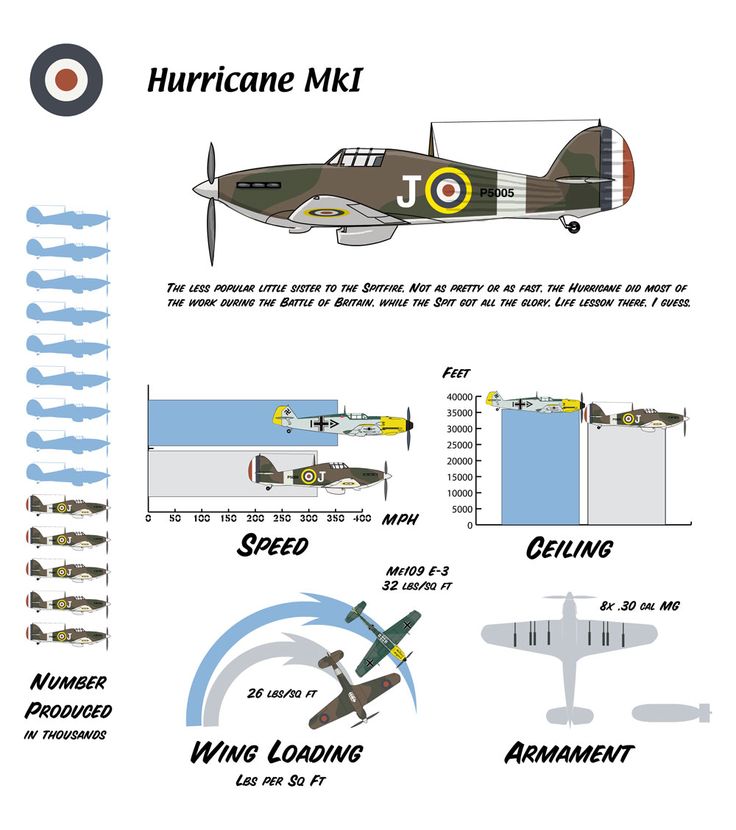 The idea of giving female names to typhoons was abandoned here, because women in Japan are considered gentle and quiet creatures.
The idea of giving female names to typhoons was abandoned here, because women in Japan are considered gentle and quiet creatures.
Photo: TASS/Smiley N. Pool/Zuma
A list of hurricane names is maintained annually, which includes 21 names, by the number of all letters in the English alphabet (except for the letters Q, U, X, Y and Z that are not used). The names of the anomalies are given in order: the first hurricane of the season is called by a name that begins with the letter A, the second with the letter B, and so on. One such list is for a year, and after six years, you can again apply the first list and repeat the names of hurricanes.
If the letters in the alphabet are over, which is extremely rare, then the 22nd hurricane is called already from the first letter of the Greek alphabet: Alpha, Beta, Gamma, Delta and others.
So far in 2017, the list of hurricane names for the Atlantic Coast is: Arlene, Bret, Cindy, Emily, Franklin, Harvey, Irma, Jose, Katya, Lee, Maria, Ophelia, Phillip, Rina, Sin, Tammy, Vince, and Whitney.
Photo: TASS/Zuma/Song Qiong
If a typhoon "distinguished itself" and became too destructive and claimed the lives of people, then its name will not be used again, as this will remind the victims of the horror experienced. For example, the name of Hurricane Katrina, which hit New Orleans in 2005 and literally washed away the city, or the name of Hurricane Charlie, which hit Florida in 2004, caused multi-billion dollar damage to the state and killed 16 people.
Recall that after Hurricane Irma, a new hurricane, Maria, hit the coast of the Atlantic Ocean, which has already reached its maximum fifth category of power.
Maria's wind speed is 260 km/h. The hurricane is located 70 km north of the French island of Martinique,
🌪🌪🌪🌪🌪🌪🌪🌪🌪🌪 #hurricanemaria
Due to the onset of the elements, an alarm has already been declared on the island of Saint Lucia, the British and American Virgin Islands, Martinique, Guadeloupe, Antigua and Barbuda.
The Atlantic hurricane season runs from early June to late November. Periodically, ocean storms turn into tornadoes. The element gets its name if the wind at the epicenter develops a speed of up to 17.4 m/s. At a wind speed of 33 m/s or more, the atmospheric phenomenon receives the status of a hurricane.
Oleneva Kristina
society weather incidents
Actions during hurricanes, storms and tornadoes.
A hurricane is a wind of tremendous destructive force, with a speed of over 30 m/s or 12 on the Beaufort scale.
A storm (storm) is a very strong, continuous wind with a speed of over 20 m/s, causing great destruction. Storms are subdivided into dust (sand) storms, dustless storms, snow storms, and squall storms.
A tornado (tornado) is an atmospheric vortex that occurs in a thundercloud and often propagates to the surface of the earth (water). It has the form of a pillar, sometimes with a curved axis of rotation, with a diameter of tens to hundreds of meters with a funnel-shaped extension at the top and bottom.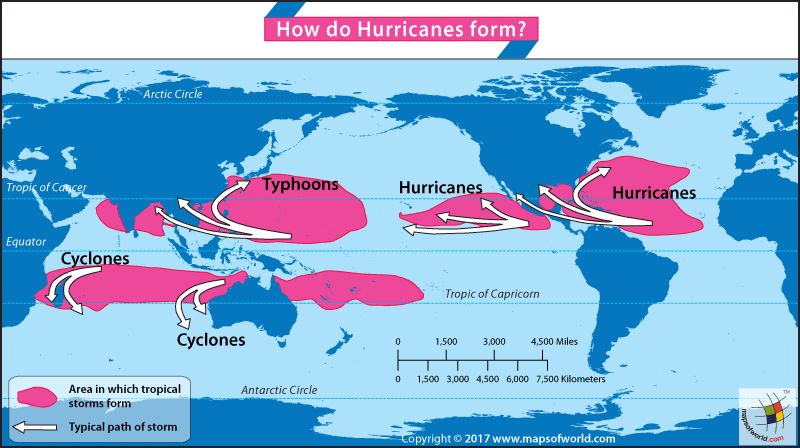
Information about the threat of hurricanes and storms is carried out in advance from the EDDS of the district to the heads of rural settlements, taking into account the provision of sufficient time for the population to prepare and occupy the selected places of protection. It carries information about the time of approach and the specific rules of human behavior that are characteristic of the current situation. The population is also aware of the possibility of occurrence and action of tornadoes.
The warning signal about the threat of hurricanes, storms and tornadoes is given by a siren and duplicated by a voice message on mobile warning systems, as well as local broadcasting stations and television.
Upon receiving the signal, the population begins work to improve the stability of buildings, structures and other places where people are located, prevent fires and create the necessary reserves.
On the windward side of buildings, windows, doors, attic hatches and ventilation openings are tightly closed.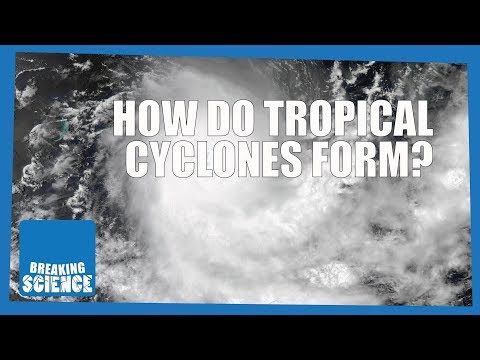 Glasses of windows are pasted over, windows and show-windows are protected by shutters or boards. In order to equalize the internal pressure, doors and windows on the leeward side of buildings are opened. Everything that can be thrown off by a hurricane is removed from balconies and loggias.
Glasses of windows are pasted over, windows and show-windows are protected by shutters or boards. In order to equalize the internal pressure, doors and windows on the leeward side of buildings are opened. Everything that can be thrown off by a hurricane is removed from balconies and loggias.
At home, residents should check the placement and condition of electrical switches, gas and water main taps and, if necessary, be able to use them. All adult members of the family must be taught the rules of first aid for injuries and concussions.
Upon receiving information about the immediate approach of a hurricane or a strong storm, residents of settlements occupy previously prepared places in buildings or shelters, and in the case of tornadoes, only basements and underground structures.
While in the building, you should beware of injuries from broken glass. In case of strong gusts of wind, it is necessary to move away from the windows and take a place in the niches of the walls, doorways or stand close to the wall. For protection, it is also recommended to use a built-in wardrobe, solid furniture and mattresses.
For protection, it is also recommended to use a built-in wardrobe, solid furniture and mattresses.
When forced to stay in the open air, it is necessary to be away from buildings and occupy ravines, pits, ditches, ditches, road ditches for protection. In this case, you need to lie on the bottom of the shelter and press firmly to the ground. Such actions significantly reduce the number of injuries caused by the throwing action of hurricanes and storms, and also provide full protection against flying fragments of glass, slate, tiles, bricks and various objects. You should also avoid being on bridges, pipelines, in places in close proximity to objects containing chemically hazardous and flammable substances (chemical, oil refineries and storage bases).
When accompanied by hurricanes and storms, thunderstorms should avoid situations in which the likelihood of electric shock increases. Therefore, during hurricanes and storms, one should not hide under separate trees, poles and masts, or come close to power transmission towers.